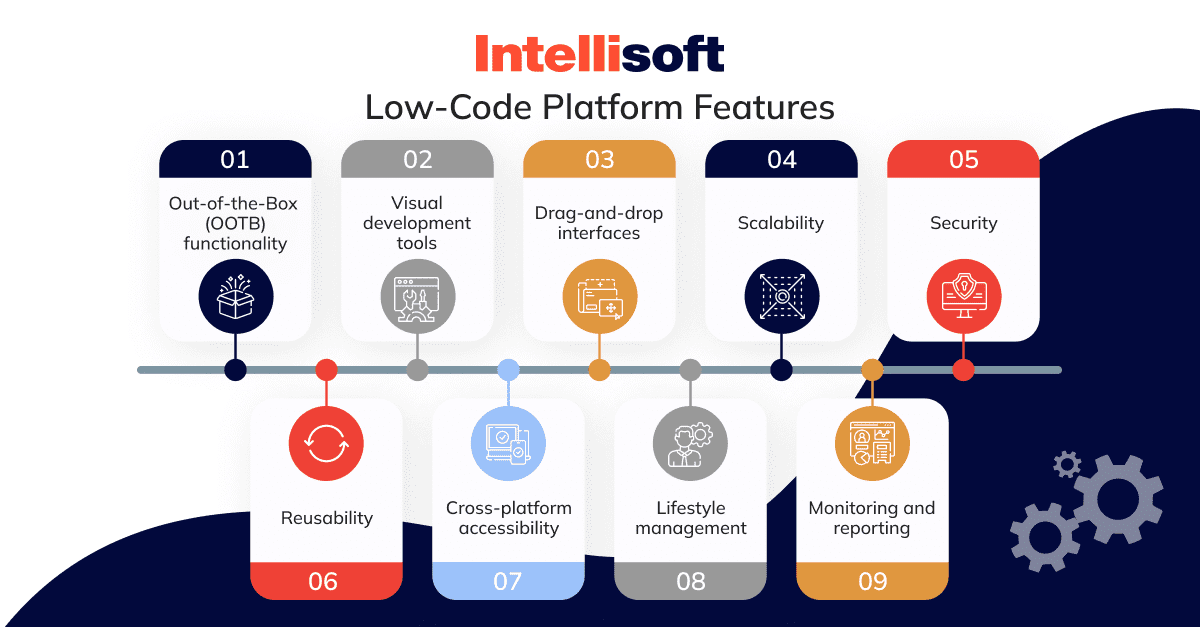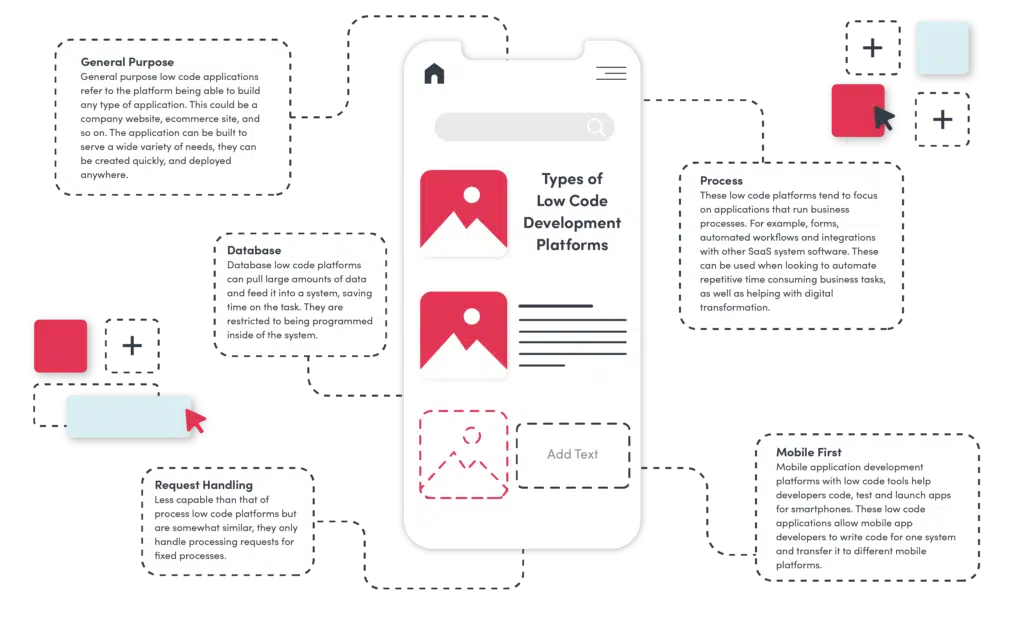Recommended News For Selecting application development with Low-code platforms
Recommended News For Selecting application development with Low-code platforms
Blog Article
Advantages Of Low-Code Application Development In Terms Of Speed
Visual Development Environment (VDE):
Drag-and-Drop Interfaces: Low-code platforms provide visual tools for designing applications. Drag-anddrop components enable developers to build apps quickly without writing code.
Many low-code platform come with already-built templates and parts. This lets developers quickly develop or prototype their applications without starting with a blank slate.
Reduced Coding Requirements:
Automated Coding Generation Low-code platforms generate the code automatically in accordance with the visual model created by developers. This eliminates the requirement to write the code manually and accelerates the development process.
Reusable Components: Developers can reuse components from different projects, thereby reducing the amount of time they spend writing and testing codes.
Collaboration Streamlined:
Low-code platforms come with a variety of tools that facilitate seamless collaboration between development teams. These include testing, version control, and deployment.
Development by citizens: Using intuitive interfaces and reducing bottlenecks, which are usually caused by the lack of developers, business users and other users can contribute towards application development.
Rapid Iteration and Prototyping
Rapid prototyping: Designers can quickly design prototypes to collect feedback and confirm ideas, which results in quicker iteration cycles.
Easy Modifications: The visual nature of low-code development makes it simpler to make changes and updates to applications, which accelerates the process of improving and refining applications based on feedback from users.
Pre-built Integrations:
API Integrations: Low-code platforms usually include pre-built connectors to popular services and APIs making it easier to integrate external systems.
Data integration tools: Tools for data integration are integrated to make it easier for the process.
Deployment and Scaling
Many low-code platforms have an option to deploy applications in one click, which reduces the time and effort required to deploy applications.
Cloud-Based Solution: Cloud based low code platforms are capable of handling infrastructure management and scaling. This lets developers concentrate more on the application logic, functionality and features, rather than deployment logistics.
The main advantage of low-code application development in terms of speed, is its capacity to automate and simplify a variety of aspects of the development process. This allows quicker delivery of applications and quicker adaptations to changing requirements. Follow the most popular Low-code Platform for application development tips for website tips including cross platform mobile dev, rad application development, rapid applications, azure sql, cross platform app dev, sso azure, cross platform mobile development, cross platform mobile dev, mobile app development platforms, cross platform mobile dev and more.
Low-Code Apps Are Affordable.
The low-code approach to app development is an affordable solution that has many benefits. It's a great option for companies looking to maximize their budgets while delivering top-quality applications. These are the major benefits: Reduced development costs
Lower Coding Requirement: Low programming platforms eliminate the need to code by hand, saving developers both time and money. This results in lower labor costs.
We require less developer resources: Low-code development takes less time and is easier. This means that less developers are needed. It could reduce the cost of hiring and staffing.
Speedier time to market
Development speed up: Visual development tools and pre-built components provided by platforms with low-code enable rapid design of applications, which allows companies to deliver products to market quicker. This will result in faster revenue growth and improve the competitive position of their products.
Rapid Prototyping: Businesses can quickly design and test prototypes, reducing the amount of time needed in the development stage and allows for quicker iterations that are based on feedback from the users.
Lower Maintenance Costs
Because of their modular architecture and common components, low-code platforms usually make it easier to maintain applications. The ongoing maintenance and support cost is reduced.
Automated Updates: Many low-code platforms can handle updates and patches automatically, ensuring applications remain secure and up-to-date without requiring lengthy manual intervention.
Efficient Resource Utilization:
Contributions by non-developers: Low-code platforms enable non-developers such as business users, to contribute to the process of development. This democratization enables businesses to take advantage of the expertise of a broad range of employees.
Improved utilization of IT resources: IT departments have the ability to focus on more strategic projects instead of being sucked into mundane development tasks. Overall efficiency and productivity improves.
Price models that are scaleable:
Subscription pricing: Many low-code platform offer different subscription pricing options that can be scaled according to usage. This allows businesses to match spending to actual requirements and growth while avoiding significant initial costs.
Pay-As You-Go: Some platforms offer pay-as you-go options. This lets businesses only pay for resources they actually need. This is especially beneficial for small and new businesses with a limited budget.
Reduction of Third-Party Costs for Software:
Low-code platforms usually come with integrated functionalities that eliminate the requirement to purchase additional tools or software. This can save you cash on subscriptions and licensing costs.
Pre-Built Integrates: By integrating popular platforms and services it can save you time and money, avoiding the necessity of creating custom integrations.
Improved ROI
A faster return on investment Rapid development: By combining less expense and a shorter speed to market, businesses are able to get a higher return on investment (ROI).
Improved agility: Companies can adjust quickly to changes in the market or in customer demand which enables businesses to remain relevant and benefit from new opportunities.
Low-cost Training:
Low-Code platforms have user-friendly interfaces. The user-friendly and intuitive interfaces reduce the learning curve of new users. This reduces the need for intense training programs.
Accessible Resources. A lot of low-code platforms offer extensive training materials, tutorials, as well community support. They eliminate the need to attend formal training which can be expensive.
Collaboration can be made easier.
Enhanced collaboration Tools: The integration of collaboration tools allows improved communication between team members as well as a reduction in project overhead.
Unified Development Environment. An unified development platform can help reduce costs and streamline workflows through reducing the complexities of managing multiple tools.
The overall cost-effectiveness of developing low-code applications stems from its ability to cut maintenance and development costs as well as speed up the time to market, improve utilization of resources, as well as provide flexible pricing models. The combination of these factors can provide businesses substantial financial benefits which makes Low-code a desirable choice for companies looking to increase their development budgets yet still creating robust and flexible applications. See the most popular Legacy application modernization with Low-code hints for website tips including app platforms, develop web application, develop mobile application, develop mobile application, develop web app, develop mobile application, develop web app, software for app development, app development platform, rad development and more.
Low-Code App Development Has Many Advantages In Terms Collaboration And Workflow
It's an excellent choice for companies that wish to improve team efficiency as well as streamline processes and enhance collaboration. Here are the major benefits: Improved Collaboration Across Functions:
Unified Development Environment : Low-code platforms provide a unified, one-stop environment where team members can collaborate effectively, including designers, business analysts, and stakeholders. This reduces barriers and improve communication.
Visual Development Visual Development: The low-code platform's visually drag-anddrop capabilities make it easy for team members who are not technical to contribute to the design process. It also ensures that business requirements are captured correctly and then implemented.
Enhanced Communication
Real-Time Co-operation: Many platforms that have low-code support live-time co-operation features like commenting, editing in parallel and getting immediate feedback. They allow for continuous communication by reducing the amount of time required for back-and-forth discussions.
Shared Workspaces : Teams can collaborate in shared workspaces. They can access edit, discuss and even discuss project components. This ensures that everyone is working towards a common objective.
Streamlined workflow management:
Tools for managing projects built-in to the platform: Low-code platforms usually come with integrated project management tools that let teams plan, track and oversee their projects. This includes the management of tasks, tracking progress and management of deadlines.
Workflow Automated: The automation of routine work, workflows, as well as other processes minimizes the manual effort required and reduces the chance of making mistakes. This allows teams to concentrate on tasks that are more profitable and improves efficiency.
Faster iteration cycles:
Rapid Prototyping: Low-code platforms allow quick prototyping and iterative development which allows teams to create prototypes, test, and refine applications in shorter cycles. This allows for quick feedback and improvements.
Agile Development Support : Support for agile methodologies allows team members to work on sprints. They are able to continuously provide small increments in functionality, and easily adapt to changes in requirements.
Accessibility for Non-Developers:
Citizens Development: Lowcode platforms enable people who use business software (citizen developers) to design as well as modify and maintain applications without extensive code knowledge. This makes it easier for IT teams as well as developers, allowing them to respond faster to the demands of business.
Training and onboarding. The intuitive tools and the extensive training materials can help a new team members to get their feet wet increasing the overall quality of collaboration.
Centralized Documentation, Knowledge Sharing and Information Sharing
Integrated Documentation: Low-code platforms provide a variety of features that permit the creation and maintaining of documentation within the platform. This makes sure that all project information is easily accessible and located centrally.
Knowledge Repositories: Teams can build and maintain knowledge repositories that include best practices, templates, and reusable components, facilitating knowledge sharing and reducing duplicate work.
Consistency Standards, Standardization and Consistency:
Standardized Components. The commonality of components across different applications guarantees consistency and makes it simpler to work with and be understood the team members.
Governance and Compliance - Built-in governance frames make sure that the creation process of all applications follows organizational standards as well as the regulatory requirements. This helps reduce the risk of non-compliance and ensures that the application is compliant with quality standards.
Feedback loops:
Integrated Feedback mechanisms: Platforms with low-code often have integrated feedback mechanisms, which allow users to give their feedback to applications. Feedback can then become incorporated into development.
Continuous Improvement: The ability to rapidly iterate on and implement changes as a result of feedback ensures the continuous improvement of applications. They are closely aligned to the requirements of users as well as business objectives.
Visualization & Reporting
Real-time analytics: Built-in analytical and reporting features give real-time insight into the progress of projects, their performance and user interaction. They facilitate data-driven, informed decision-making.
Visual Workflow Mapping Visual tools that show workflows and process can assist teams in optimizing their workflows by identifying bottlenecks.
The main benefits of low-code application development in terms of workflow and collaboration lie in its capacity to unite teams from different backgrounds as well as streamline communication and also automate processes. This fosters a team-oriented environment that is agile and efficient in its process for development, which results in better-quality applications and better alignment between business goals.